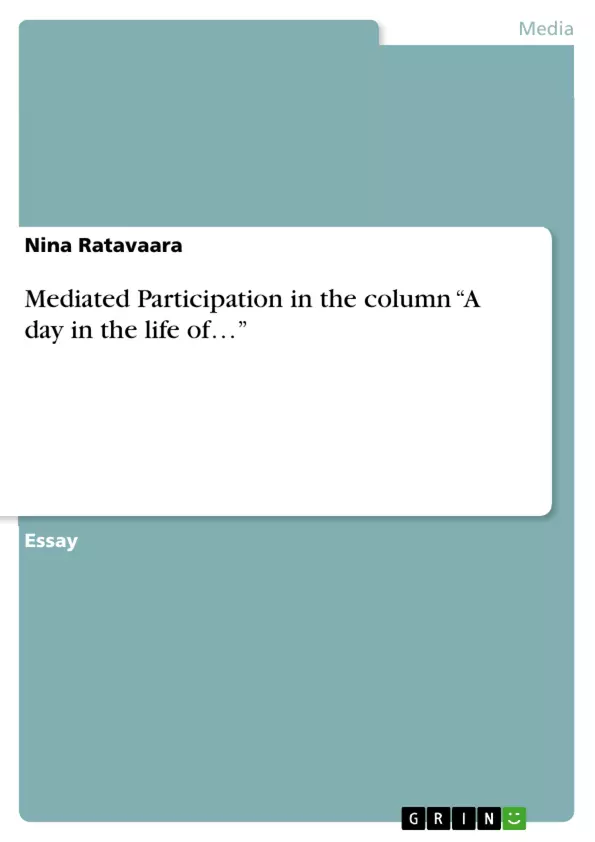This essay combines theory of power relations and identity construction in mediated participations with a case study. The two theoretical aspects are essential to consider when talking about participation in media because there are different definitions, grades, and perspectives on participation. What might seem like full participation might be restricted and controlled more than is visible to the first glance. On the other hand there might be signs and hints of resistance and usage of the participation platform for one’s own benefit, e.g. by constructing a favourable identity.
Both old and ‘new’(mass) media play an important role in society and with the rise of the so called ‘new media’ interaction, interactivity, and participation of consumers, ‘ordinary’ people, and citizens have become approaches both in business strategies as well as in democratization enhancement visions. In this essay the term ‘participation’ carries a political connotation following Mouffe’s description which defines the “political as a domain of the social, which can emerge in a wide range of social relations […] Moving into the world of trans-politics, this wide range of social relations would arguably include both mediated social relations and social relations within the media system itself.” (quoted in Carpentier 2009b, pp. 4) There exists participation in and through media. The important characteristics of participation through media are the allowance for participation in public debates and self-representation in the public sphere. (Carpentier 2009b, pp. 4) Participation in media addresses the production of media output by non-professionals. There are fewer examples of mainstream media allowing for this kind of participation than alternative media. In the small number of examples an in-depth examination and evaluation of the power relations and existing imbalances needs to be done by the media professionals. (Carpentier 2009b, pp. 4)
The ‘new’ media also eclipsed the already existing participatory potential of the traditional media which leads to three capital errors. As already mentioned, the significance of the traditional media is not taken into account. But they still have a permanent place in the lives of many- be it because of tradition, lacking access to ‘new’ media or because those media types are still central players to create relevance.
Inhaltsverzeichnis (Table of Contents)
- Introduction.
- Power relations..
- Identity construction.....
- Case study
- Conclusion.......
- References..
- Case study references ....
- Photo appendix.
Zielsetzung und Themenschwerpunkte (Objectives and Key Themes)
This essay explores the concept of mediated participation, analyzing power relations and identity construction in the context of media interactions. It utilizes a case study to illustrate these theoretical aspects, highlighting the complexities of participation in a mediated environment.
- Power relations in media participation
- Identity construction in the context of mediated interaction
- The role of traditional and new media in participation
- The significance of transparency and visibility in power dynamics
- The impact of professional roles and attitudes on participation
Zusammenfassung der Kapitel (Chapter Summaries)
The introduction sets the stage for the essay by defining mediated participation and its significance in the context of power relations and identity construction. The theoretical framework is established, emphasizing the complexities and nuances involved in understanding participation in a mediated environment. The essay highlights the importance of examining both traditional and new media in relation to participation, recognizing the evolving landscape of media engagement.
The chapter on power relations delves into the dynamics of power in mediated participation, emphasizing the visibility and invisibility of power structures. The essay analyzes the roles of media professionals and non-professionals in shaping the participation experience, highlighting the influence of organizational elements and professional attitudes on the power dynamics.
The chapter on identity construction explores the multifaceted nature of identity in the context of mediated participation, examining both individual and collective identities. It delves into the interplay of discourses and markers in shaping identity, focusing on the roles of platforms, media professionals, and individuals in constructing and expressing identity.
Schlüsselwörter (Keywords)
Mediated participation, power relations, identity construction, transparency, visibility, traditional media, new media, professional roles, non-professional participation, media platforms, corporate identity, citizenship, national identity, discourses, markers, habitus.
- Arbeit zitieren
- Nina Ratavaara (Autor:in), 2009, Mediated Participation in the column “A day in the life of…”, München, GRIN Verlag, https://www.grin.com/document/178934



